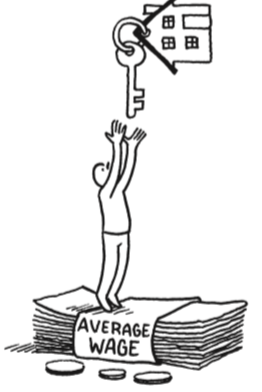Private Rent post COVID-19 – the time has come for Cost Rental

There are 695,142 occupants in the private rented sector across 336,890 registered tenancies[1]. 29,542 of these tenancies are accommodated through Approved Housing Bodies (AHBs) and the total number of registered landlords is 173,197. While some renters get help paying that rent by way of the Housing Assistance Payment (HAP) or the Rent Supplement payment, according to the RTB Rent Index for Q4 2019 the Standardised Average Rent nationwide was €1,226.16 – 24 per cent higher than Q4 2007 before the last financial crisis and 64 per cent higher than its lowest point since, in Q1 2012. As we navigate our way through another crisis, it is time to uncouple our basic housing need from the boom-bust cycle of the property market.
Because the rent is set by the landlord as part of a rental market, and isn’t connected to anything to do with the property itself or how much income a tenant has, this is called “market rent”. Market rents, like the price of anything else you might buy, can go up or down. Sharp movements in price like this in any market are usually a sign that things are not working as they should.
Fixing the Irish rental market will need a combination of many different things. Social Justice Ireland and others would argue that part of the long-term solution is the introduction of Cost Rental to the Irish housing system.
Cost Rental is a system where rent is based only on recovering the cost of providing the home. Because there is little or no profit for developers or landlords, the rent is usually much lower than normal market rent. The rent the tenant pays has nothing to do with the market (unlike in the private sector), and nothing to do with the tenants’ incomes (unlike in Local Authority accommodation).
There have been many discussions in the last number of years about what cost rent would actually cost the tenants, and while a number of small projects have been piloted in Ireland to date, the scale has been insufficient to meet demand or have any real impact on the market prices. Some estimates put the cost at about €1,300 for a family home, while others are a bit higher. The reality is, cost rents will be higher than social rents, which are charged to tenants of the Local Authority or Approved Housing Body based on what they earn, however they should be lower than market rents. An additional advantage to cost rental is that, as the costs of delivering the property decrease (for example, finance costs decrease as loans are paid down), so too should the rent. So older tenants who have been renting their home for 25-30 years should see their rent decrease in line with an expected decrease in income. The link between income and housing in older age should be a pressing policy concern as private pension coverage is low and the State pension is insufficient to cover a private rent and living costs.
Cost rental works well in other countries. In Austria, for example, almost half of the population live in rented accommodation. Because cost rental properties are widely available, the market is based on competition between private and public rentals, not just the private sector which is driven by profit. This means that the cost of renting is generally lower than in Ireland.
Most housing in Austria is built with some sort of subsidy. Long-term, low-interest loans from the State cover about a third of the cost. Private savings used to finance social housing are also given a tax break[2]. Tenants can also get a subsidy, but because of the high proportion of social housing and cost rental, as well as the relatively low market rents, the share of tenants needing them is low. Also, because subsidies reduce the cost to provide the housing, rents that are based on those costs are naturally lower. Another interesting thing about Austria’s cost rental model is that costs are based on individual developments. Maximum rents are set as part of the financing arrangements, that is, they are set out in the loan agreements used to finance the development the finance documents. Competition is therefore local and low level.
Compare this to Ireland, where even with rent pressure zones limiting rent increases to 4 per cent each year in some areas of the country, rents have been increasing for the past eight years. The cost of rent subsidies to the taxpayer are increasing every year. In fact, Local Authorities expect to pay over €1 billion in HAP, Rental Accommodation Scheme (RAS) and Leasing payments this year[3].
Delivering cost rental in Ireland requires a radical policy shift, away from the idea that property ownership is an absolute right, and towards increased rights for tenants and the establishment of long-term tenancies. This is a particular issue for older tenants who face increasing rents on reduced income as they retire, but has wider implications for young people wanting to move out of their family home and couples starting families.
Cost Rental will require upfront investment to develop, financed at a low enough rate to make the cost rent reasonably affordable. In June 2018, Social Justice Ireland produced a model of cost rental that could be financed outside of the general government balance sheet[4].
With more of us renting into the future, it’s vitally important that affordable rental is seriously explored. A cost rental model would be a major step in that direction.
[1]https://onestopshop.rtb.ie/images/uploads/general/RTB_Annual_Report_2018...
[2]http://files.nesc.ie/nesc_reports/en/138_Social_Housing.pdf
[3]www.localauthorityfinances.com
[4]https://www.socialjustice.ie/content/policy-issues/making-rent-affordabl...